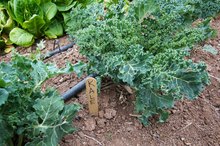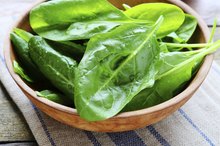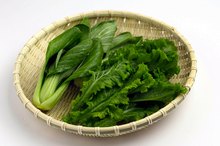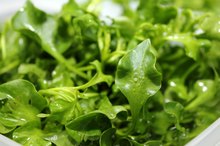Filipino Vegetables & Their Benefits
The Philippines is a tropical country that uses a variety of vegetables in its cuisine. Most of the vegetables are unique to tropical climates. You will see a variety of Filipino vegetables used in soups as well as fish, chicken, pork, beef and even goat entrees. The vegetables are prepared raw, pickled, steamed, boiled or fried, depending on the dish. Filipino vegetables offer a variety of benefits, providing nutrients, vitamins and minerals.
Water Spinach
Also known as water convolvulus or swamp cabbage, water spinach is an aquatic plant with dark green heart-shaped leaves and hollow bright green stalks. Known as kangkong in Filipino, water spinach is an all-year-round vegetable and can easily be cultivated. Water spinach is rich in vitamin K, which helps promote healthy bones and teeth. Water spinach decreases the risk of developing osteoporosis, a disease where your bones become porous, increasing the risk of developing bone fractures. Consuming water spinach also decreases the risk of developing hemorrhage, as it helps coagulate the blood properly.
Bitter Gourd
How to Blanch Kale
Learn More
Bitter gourd, or ampalaya in the Philippines, is a common Filipino vegetable with a bitter-tasting flavor. Bitter gourd, or bitter melon, contains iron and is used as a medicinal vegetable in Philippine folk medicine. Though not fully studied, bitter melon may have a beneficial effect in patients suffering from type 2 diabetes, Drugs.com reports. However, the vegetable has yet to be fully tested and should not be used in replacement for typical diabetes medications. Talk to your doctor before adding large quantities of bitter gourd to your diet.
Horseradish Tree
The horseradish tree, or malunggay, is a sturdy, edible tree. The tree's leaves are fibrous and are used in a variety of Filipino dishes. The leaves are a good source of beta carotene, a form of vitamin A that fights off free radicals. Horseradish tree leaves are also rich in protein, vitamins A, B and calcium.
Sweet Potato
Choline Rich Vegetables
Learn More
Sweet potato, called kamote in Filipino, is a root crop vegetable that is both fat-free and cholesterol-free, and can be eaten baked or fried. Sweet potato is rich in vitamin A and beta carotene. Vitamin A is a fat-soluble vitamin that is responsible for developing your body’s mucous membrane, skin and bones. Beta carotene, an antioxidant, helps reduce the risk of cardiovascular problems.
Related Articles
References
- Mayo Clinic; Vitamin K; Steven D. Ehrlich; June 2009
- "Ecology of Food and Nutrition"; Adoption of Moringa Oleifera to Combat Under-Nutrition Viewed Through the Lens of the “Diffusion of Innovations” Theory; Melanie D. Thurber and Jed W. Fahey; May 2009
- The "New York Times"; Vitamin A; Linda Vorvick; March 2009
- Drugs.com: Bitter Melon
Writer Bio
Joseph Pritchard graduated from Our Lady of Fatima Medical School with a medical degree. He has spent almost a decade studying humanity. Dr. Pritchard writes as a San Francisco biology expert for a prominent website and thoroughly enjoys sharing the knowledge he has accumulated.









